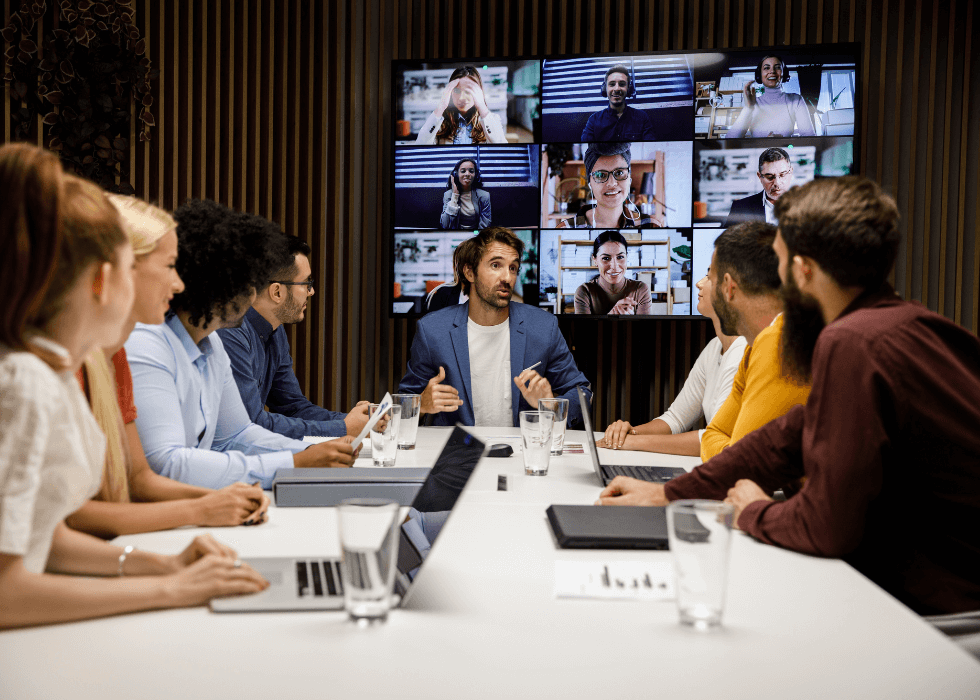News & Trends
Meeting Room Management Simplified: How to Streamline Your Meetings
Have you ever imagined orchestrating a global symphony of technology, seamlessly connecting thousands of meetings spread across the vastness of continents without ever missing a beat?
Complexity and cost converge. Efficiency becomes the maestro of this vast digital ensemble, driving performance with precision, as centralized video conferencing control harmonizes the technical cacophony into a symphony of collaboration.
Centralizing Meeting Room Technology
In pursuing operational harmony, embracing a centralized approach to meeting room technology becomes imperative. This architectural pivot streamlines the management of disparate audiovisual elements by consolidating command within a singular, intuitive platform. By doing so, organizations achieve a fluidity in communication that transcends geographical boundaries, fostering a cohesive and consistent user experience across the global enterprise stage.
Integrating Video Conferencing Systems
Uniformity and interoperability are pillars of efficient video conferencing integration. They eliminate mangling between diverse technologies, ensuring a smooth meeting experience regardless of location or device.
Central control empowers consistency in functionality, creating a "universal meeting language." This consistent user interface across all meeting rooms minimizes training needs, increasing adoption rates and enhancing collaboration.
FACTOID: Over 80% of communication is nonverbal, emphasizing the importance of reliable video conferencing systems.
Advanced video conferencing integration: more than unified access to hardware like cameras and microphones, it standardizes software platforms, ensuring robust performance and user familiarity. A singular touchpoint simplifies end-to-end management.
Simplifying Device Management
Efficient device management begins with a centralization strategy, streamlining maintenance and oversight across global operations.
- Catalog All AV Equipment: Enumerate and assess your inventory of cameras, microphones, screens, and video bars.
- Consolidate Control Systems: Implement a centralized management platform for all AV devices.
- Standardize Configuration Settings: Harmonize settings across devices for a unified user experience.
- Automate Software Updates: Employ systems that automatically update software across all devices.
- Designate Remote Troubleshooting: Setup remote access for on-the-fly adjustments and issue resolution.
Centralized control transforms AV management, reducing hands-on time and improving system reliability. Simplified management ultimately leads to cost efficiencies and a cohesive meeting environment.
Remote Access and Control
Remote access enables technicians to troubleshoot issues without being physically present. With IP-based control systems, real-time AV equipment adjustments are feasible and highly efficient.
Central management platforms allow for seamless firmware updates and configuration changes from thousands of miles away.
Empowering remote support specialists to access and rectify faults promptly ensures minimal downtime and consistent reliability.
Thus, remote control is a linchpin in achieving streamlined, unobtrusive AV maintenance.
Enhancing User Meeting Experience
To ensure the facilitation of a streamlined user meeting experience, the adoption of a centralized control platform is critical. This framework aligns technological functionalities across disparate geographies, yielding participants a harmonious and intuitive interface. With such a system, inconsistencies evaporate, ushering in a unified experience that facilitates engagement and fosters collaboration. The result is an environment where technology becomes a silent partner in productivity rather than a source of distraction or frustration.
Streamlining Meeting Startup
A central control system is the heart of meeting room management, facilitating a quick transition from room reservation to meeting commencement. No longer is there a need to fumble through settings or verify connections; with preconfigured profiles, a room can transition from idle to active within moments. Consequently, starting a meeting becomes as straightforward as pressing a single button. Activation takes mere moments, ensuring prompt starts.
Integrating room booking systems and AV equipment automatically prepares the space for the users' arrival. This intelligent synchronization tailors environment settings to the meeting's specifics, negating unnecessary setup time.
Efficiency is embodied in every aspect of the meeting lifecycle. Using occupancy sensors can further automate room readiness, initiating system wakeups and configurations when attendees approach, ensuring a welcoming, ready-to-use space. With the latest industry advancements, such controls are increasingly intuitive and customizable, reflecting the need for agility in the modern meeting landscape. This proactive approach not only enhances user experience but also cultivates an atmosphere of efficiency within the enterprise.
Addressing Audiovisual Consistency
Achieving uniformity in AV setups across locations is pivotal for seamless enterprise communication.
- Standardize Equipment: Use the same models of video cameras, microphones, and screens to ensure consistency.
- Unified Software Solutions: Implement standardized conferencing software across all meeting spaces.
- Centralized Configuration: Regularly update and manage settings from a single control point to maintain uniform user interfaces.
- Scheduled Maintenance: Conduct consistent maintenance checks to prevent discrepancies in AV quality and performance.
- User Training: Provide comprehensive training for end-users to familiarize them with the consistent AV setup.
Consistency eliminates the learning curve with each new space encountered. Leveraged correctly, it leads to smoother, more professional meeting experiences.
Facilitating On-Demand Collaboration
On-demand collaboration requires reliable AV technology that mitigates downtime or technical delays. To streamline meetings, systems must integrate seamlessly, allowing participants to start collaborations effortlessly at a moment's notice.
Centralized video conferencing systems thus offer instant connectivity, mitigating cumbersome setup processes for users scattered across the globe.
Visual clarity, audio fidelity, and ease of access are necessary for on-the-fly decision-making, necessitating advanced AV solutions maintained via centralized management.
Dynamic collaboration flourishes when technological barriers are removed, allowing enterprise talent to focus on ideation rather than navigating AV intricacies.
Cost-Effective Meeting Solutions
Incorporating a centralized control system for video conferencing assets across global enterprises reaps considerable financial benefits. Eliminating the need for local tech support in each meeting space and streamlined device maintenance precipitates notable cost reductions. These economies of scale are vital for businesses looking to optimize operational budgets without compromising the integrity of their communication infrastructure.
Efficient management of AV equipment through a single point of control lowers direct costs and reduces indirect expenses related to time wastage and productivity loss. This centralized approach ensures that teams spend less time grappling with technology and more time engaging in the valuable exchanges that drive business forward.
Economies of Scale in Tech Deployment
Integrating AV technology on a large scale inherently drives down costs per unit. This principle is magnified across global deployments, where consistency and volume equate to significant savings.
Organizations can negotiate favorable terms that substantially reduce the cost of equipping multiple meeting spaces by leveraging bulk purchases for hardware, such as video cameras and microphones. Similar benefits are reaped when procuring software licenses in volume for video conferencing platforms.
However, the savings extend far beyond the initial acquisition. Centralized management allows for unified software updates, hardware maintenance, and streamlined troubleshooting, lowering long-term operational expenditures.
Moreover, a single configuration across all devices eliminates inconsistencies, reducing user training time and related support costs. Simplified operational processes translate into financial efficiency, particularly when amplified across an enterprise's global framework.
Implementing these strategies results in not just cost savings but also an enhanced user experience—one that supports the core mission of modern enterprises: uninterrupted, fluid communication regardless of geographical constraints.
Cutting Down on Technical Staffing Needs
Centralized control significantly reduces the need for on-site technical teams. Expertise can be centralized, with remote troubleshooting and management forming the backbone of modern AV operations.
Automation and intelligent management software are revolutionizing on-site staffing requirements for AV setups. Centralized control allows fewer personnel to manage more equipment, reducing staffing costs without compromising system performance or availability. Remote health monitoring and proactive maintenance further reduce the need for on-site technical presence, allowing issues to be resolved swiftly from a central location.
Streamlined management workflows eliminate the necessity of AV specialists at each location. This centralization of control enables a rapid response to any technical challenge, ensuring that meetings are not delayed or disrupted by equipment issues. It also shrinks the necessity for costly routine on-site checks, instead relying on remote diagnostics for swift resolution.
Ultimately, centralized video conferencing control means enterprises can minimize the extensive costs of widespread technical staffing. Efficient allocation of skilled personnel can now focus on strategic oversight and continuous improvement of the AV infrastructure. This maximizes talents and fosters a more sustainable operation model, with significant savings and enhanced global communication.
Reducing Redundancy and Waste
Centralized control of AV technology minimizes equipment redundancy and streamlines maintenance processes.
- Audit and rationalize equipment: Evaluate the necessity of each device, consolidating where possible to reduce excess.
- Implement remote diagnostics: Use centralized monitoring to troubleshoot and reduce physical site visits preemptively.
- Standardize configurations: Harmonize systems across the board to ensure uniformity and ease of use.
- Adopt scalable solutions: Choose technologies that can grow with the enterprise, avoiding short-lived, non-upgradable options.
- Optimize resource allocation: Utilize data gathered to deploy human and technical resources more effectively.
Sustainable practices are enforced, optimizing the lifetime of each device and decreasing electronic waste. Perhaps more importantly, efficiency is realized through reduced capital and operating expenditures, bolstering overall enterprise sustainability.
Implementing Smart Meeting Management
Embarking on the journey to intelligent meeting management requires a comprehensive shift in approach, leveraging IP technology to unite disparate AV systems. By centralizing control, enterprises create a cohesive ecosystem where video cameras, microphones, and screens operate harmoniously. Consistency in user experience becomes a reality, no longer hampered by localized configurations and varying standards of operation. This strategic consolidation is achieved through a detailed mapping of current systems, followed by deploying robust, centralized management software to monitor, manage, and maintain equipment across all locations. As a result, meetings are streamlined, reliable, and poised to facilitate effective communication regardless of the global footprint.
Adopting IP-Based Control Systems
IP-based control systems are the centralized conduits for modern meeting management. They enable remote monitoring and management of AV equipment across the enterprise spectrum.
By transitioning to IP-based control, companies orchestrate AV activities from a nucleus that commands global operations. It's a transformative approach, eliminating traditional barriers in enterprise AV management and enabling fluid, scalable solutions.
Such systems embrace an IT-centric model, converging AV with existing corporate networks. This convergence streamlines support, engenders remote troubleshooting, and fosters proactive maintenance, all from a centralized location.
Integration of IP control systems signifies a commitment to efficiency. It translates to less downtime, swift configuration changes, and a unified user experience for seamless enterprise communication.
Leveraging this technology ensures consistency and reliability in communication infrastructures, which is critical for global enterprise success. It's about making complex systems simpler and more effective.
Training for Seamless Operation
Practical training yields proficient system users.
To fully leverage centralized video conferencing control systems, a comprehensive training regimen is essential for enterprise teams—particularly AV and IT departments. With proper instruction, teams become adept in managing intricate hardware configurations, thus ensuring coherent, consistent operational protocols across the organization. Therefore, competency in use translates to maximized benefits of integrated meeting management solutions.
Familiarity with the system fosters quick adaptation.
Not only must the technical staff be well-versed in control systems, but routine users of meeting spaces, too—such as executives, managers, and support staff—must grasp the interface operations. This underscores the need for intuitive interfaces that support quick, efficient meeting startups and enhance user adoption and satisfaction rates.
The goal is aligned with technological empowerment.
Continual education and updates are imperative for organizations to keep pace with the ever-evolving AV landscape, particularly with IP-based technologies that headline industry standards in 2023. Ongoing training sessions maintain knowledge of new features and upgrades, fostering an environment where technology enhances, rather than hinders, the meeting experience.
Monitoring and Analytics for Continuous Improvement
Centralized management platforms offer real-time monitoring, ensuring all devices perform optimally, preventing downtime. Analytics allow proactive issue resolution, improving overall system reliability.
Effective analytics translate into actionable insights, elevating service quality. Pinpointed metrics guide strategic improvements, streamlining processes.
Continuous performance data collected from global endpoints empowers enterprises to make informed decisions. Understanding patterns in usage and identifying frequent issues contribute to a more robust, efficient meeting infrastructure.
Leveraging advanced analytics tools enables the prediction of trends and preemptive problem-solving strategies. This predictive approach minimizes disruptions, facilitates quicker response times, and can lead to a self-healing ecosystem that autonomously addresses minor issues before they impact user experience. With data-driven decisions, what was once "reactive" shifts to "proactive" in maintaining high-quality meeting environments.
Ready to learn more about conferencing and collaboration? Subscribe to our newsletter!















